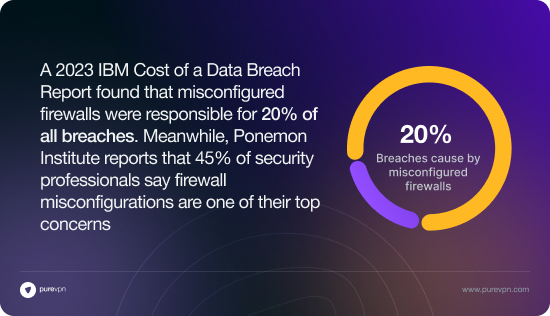Table of Contents
Firewalls are supposed to be the first line of defense. But the reality? Misconfigurations happen all the time, and they can leave networks wide open to attacks.
A 2023 IBM Cost of a Data Breach Report found that misconfigured firewalls were responsible for 20% of all breaches. Meanwhile, Ponemon Institute reports that 45% of security professionals say firewall misconfigurations are one of their top concerns.

Here are five common firewall misconfigurations that could be putting your network at risk.
1. Overly Permissive Rules
It’s easy to start with tight security policies, but over time, rules get added, exceptions get made, and suddenly, everything is wide open. Instead of restricting traffic, the firewall becomes a gateway for threats.
Think of it like having a locked front door but leaving all the windows open. According to Gartner, 99% of firewall breaches will be caused by misconfigurations rather than flaws in the firewall itself. Attackers love these gaps.
2. Default Settings Left Unchanged
Firewalls come with default configurations, and guess what? Hackers know them by heart. If you don’t tweak these settings, you’re essentially handing them an open invitation.
Example? The MGM Resorts cyberattack in 2023 reportedly stemmed from unpatched systems and default configurations being exploited. One weak spot was all it took. In fact, 60% of organizations that suffered breaches in 2022 had failed to change default security settings, according to a Verizon DBIR report.
3. Unmonitored Firewall Logs
Firewalls generate tons of logs, but how often does anyone actually review them? If no one’s watching, potential attacks slip through unnoticed. IBM estimates that 60% of security breaches go undetected for months, giving attackers plenty of time to do real damage.
A recent study by Cisco found that 44% of security alerts are ignored due to overwhelming volume. That means threats are actively bypassing firewalls simply because there isn’t enough monitoring in place.
4. Misconfigured VPN Access
Firewalls should allow VPN traffic, but it needs to be done securely. A misconfigured VPN port or excessive access permissions can expose sensitive business data.
That’s why PureVPN for Teams ensures dedicated IPs and access control, reducing attack surfaces while keeping remote teams securely connected. A 2023 Cybersecurity Insiders report found that 65% of organizations have at least one misconfigured remote access setting that could lead to a data breach.
5. Inconsistent Updates and Patch Management
A firewall that isn’t updated is just as bad as having no firewall at all. Attackers constantly exploit known vulnerabilities, and if patches aren’t applied, they have a field day.
70% of exploited vulnerabilities are at least two years old, according to Palo Alto Networks’ Unit 42. That means businesses are getting hit by issues that already have fixes—just ones that weren’t applied.
Locking Down Your Firewall Security
A firewall is only as strong as its configuration. If rules are too loose, logs go unchecked, or updates are ignored, your security posture weakens.
With PureVPN for Teams, IT managers get centralized control, secure remote access, and visibility into traffic—reducing the risk of firewall misconfigurations.
A strong firewall setup isn’t just about having one—it’s about configuring it right.





